Indexed In
- Open J Gate
- Genamics JournalSeek
- Academic Keys
- JournalTOCs
- ResearchBible
- China National Knowledge Infrastructure (CNKI)
- Scimago
- Ulrich's Periodicals Directory
- Electronic Journals Library
- RefSeek
- Hamdard University
- EBSCO A-Z
- OCLC- WorldCat
- SWB online catalog
- Virtual Library of Biology (vifabio)
- Publons
- MIAR
- Scientific Indexing Services (SIS)
- Euro Pub
- Google Scholar
Useful Links
Share This Page
Journal Flyer

Open Access Journals
- Agri and Aquaculture
- Biochemistry
- Bioinformatics & Systems Biology
- Business & Management
- Chemistry
- Clinical Sciences
- Engineering
- Food & Nutrition
- General Science
- Genetics & Molecular Biology
- Immunology & Microbiology
- Medical Sciences
- Neuroscience & Psychology
- Nursing & Health Care
- Pharmaceutical Sciences
Research Article - (2024) Volume 15, Issue 4
Assessment and management of Cognition and motor impairment after stroke through exploratory data analysis and formulation of a model incorporating conventional existing and newer neuro-technology tools.
Nahid kouser*, Deepak lohar, Jafar khan and Atulabh vajpayeeReceived: 01-Jul-2024, Manuscript No. jnmnt-24-26290; Editor assigned: 04-Jul-2024, Pre QC No. jnmnt-24-26290(PQ); Reviewed: 18-Jul-2024, QC No. jnmnt-24-26290(QC); Revised: 25-Jul-2024, Manuscript No. jnmnt-24-26290(R); Published: 31-Jul-2024, DOI: 10.35248/2157-7439.24.15.737
Abstract
Stroke is defines as a sudden neurological deficit caused by focal vascular lesion. Stroke is a potentially life changing event that can have lasting physical and emotional effects. Cognition is a term that refers to the mental processes involved in acquiring information and understanding. These cognitive processes include thought, learning, recalling, evaluating, and solving problems. Stroke affects the cognitive domain, which includes attention, memory, language, and orientation. The most affected domains are attention and executive functions; at the time of stroke diagnosis, memory problems are often prominent. whereas Motor impairment refers to a condition in which an individual experiences difficulties or limitations in the control and coordination of body movements. Motor impairment can affect both gross motor skills (involving larger muscle groups and movements) and fine motor skills (involving smaller, more precise movements).
Porpuse: We aimed to optimize therapeutic multidisciplinary, multimodality neurorehabilitation interventions, neurotechnology and tools in large prospective cohort through data analysis.
Subjects and method: After the approval of institutional ethical committee, ischemic stroke between 18-60 years of age group patients were selected for the study based on the inclusion and exclusion criteria .we had created 2 groups in which we did advance plus conventional and conventional rehabilitation .the data was taken by using NIHS, MRS. The data was analyzed at the time of admission then 3rd month follow up then every 3 monthly till 2 year of enrollment.
Result: conventional and newer technology tools were compared using the chi square test for quantitative variables .there was a significant difference found in both the groups..p value was obtained by comparing both the groups [conventional rehabilitation and conventional plus advanced rehabilitation] after 3 months, according to the NIHS scale the p value was 0.297 which is non-significant ,according to the MRS there was highly significant value which was 0.0004 .
Conclusion: In this study both treatment groups obtained successful outcomes as measured by NIHS, MRS. There was significantly difference found between the two groups at these scales .the result of this study showed that the newer technology tools can decrease the cognitive impairment after stroke, there was also observed that newer technology tools give faster recovery as compared to the conventional rehabilitation alone
Keywords
Stroke, Rehabilitation, Cognition impairments, Motor impairments, newer technology tools
INTRODUCTION
Cognition is a term that refers to the mental processes involved in acquiring information and understanding. These cognitive processes include thought, learning, recalling, evaluating, and solving problems [1]. Stroke affects the cognitive domain, which includes attention, memory, language, and orientation. The most affected domains are attention and executive functions; at the time of stroke diagnosis, memory problems are often prominent [2]. In the past, the researchers identified the dementia after stroke as the vascular dementia but not all stroke survivors who suffer from the cognitive decline meet the criteria of the dementia. As a result, the vascular cognitive impairment (VCI) took over the past “vascular dementia”. However, there’s evidence suggesting that the cognitive impairment after stroke is involved in not only the VCI, but also the pathogenesis of Alzheimer’s disease (AD) [3]. The clinical study suggested that the pathogenesis of AD make contributions to the 1/3 demented cases after stroke [4]. The risk of the cognitive impairment after stroke is associated with the overlap of the frequent cerebrovascular disease and the dementia. According to the demography, the age and the education level are related to the post-stroke cognitive impairment risk. The age is the risk factor of not only the stroke but also the cognitive decline. There’s evidence suggesting that the prevalence of the cognitive decline after stroke would increase exponentially as age increases after 65 years old [5]. One of the most important areas affected by stroke is motor skills. The patients may have disabilities in different degrees (mid, acute, severe), in different hemispheres (one or both), and at different levels: upper (face, neck), medium (trunk, upper limbs) and lower (lower limbs). Hemiparesis and motor recovery have been the most studied of all stroke impairments. Hemiparesis defined as muscular weakness or partial paralysis restricted to one side of the body is an impairment present in 88% of the stroke patients, affecting lower and upper limbs. Six months after stroke about 38% of patients lightly recovers dexterity in the arm and only 12% shows full recovery after conventional rehabilitation therapy [6].Weakness and paresis are the most important impairments on the early stages after stroke as they lead to a learned nonuse of limbs. Immobility, chronic pain, and some sensory impairments can also contribute to the learned nonuse state. As the recovery progresses, spasticity and spastic co-contractions can induce some compensatory movements, which if are persistent in time and repeated may contribute to a learned bad use. The motor deficits resulting from an ischemic stroke to the three major cortical motor control regions of the brain, namely primary motor cortex, premotor areas and parietal cortex. Following the introduction, a detailed description of stroke and its pathophysiology is presented. This is followed by a discussion on the role of the primary motor cortex, premotor areas and parietal cortex in the normal voluntary control of movements. The motor deficits due to a stroke in these three cortical regions is discussed [7]. In absence of uniform practices and guideline for use conventional physiotherapy, occupational therapy, speech therapy and cognitive rehabilitation couple with advent of newer neurotechnology tools, interventions, robotics, artificial intelligence, bionics confuses to make a choice for a particular subset of patients. Moreover many software like bimeo Virtual reality (VR), sensor system for upper limb will cost approx. 50,000 euros and need for different VR, AI tools will make therapy very costly with no proven efficacy. As of now there is no single combination of comprehensive software or hardware meeting most if not all need of post stroke cognitive and motor impairment. Second challenge is to deliver this expertise through tele neurology in era of better connectivity of internet even in remote areas [8]. Many patients especially in rural and tribal India are not motivated to undertake neurorehabilitation Programme due to many reasons like financial constraints, paucity of local facilities and expertise, discouraging short term results, lack of clear guidelines. In fact, people in few religious places outnumber those registered with neurorehabilitation Programme. We aim to optimize therapeutic multidisciplinary, multimodality neurorehabilitation interventions, neurotechnology and tools in large prospective cohort through data analysis.
Purpose
As of now there is no single combination of comprehensive software or hardware meeting most if not all need of post stroke cognitive and motor impairment. Therefore we aimed to optimize therapeutic multidisciplinary, multi-modality neurorehabilitation interventions, neurotechnology and tools in large prospective cohort through data analysis.
We intended to analyze patient data with their cognition and motor impairment and compared various neurotechnology tools to make a model to predict best therapeutic tools for specific subset of patient population based on their outcome up to 2 year.
We have assessed the cognition and motor improvement in post stroke patients through comparative data analysis.
We have collected data with assessment scales from enrolled patients in the study.
We have analyzed data through statistics to correlate the explored data and make a model for use in impairment specific patient population after stroke.
MATERIALS AND METHODOLOGY
Study design: Hospital based control trial study
Location of the study: Outpatient and inpatient department of pacific medical college, Department of Neuroscience, Research Lab, Pacific Medical College and Hospital, Pacific Medical University, Udaipur Rajasthan India.
Study population: All ischemic stroke patients
Duration of the study: 2 Years
Sampling tachnique: Convinient sampling
Sample size: 200 Patients, 50 in each group
Patients who met the inclusion criteria were enrolled in the study. Informed Consent has been obtained. Assessments have been done using national institute of health stroke- scale (NIHSS) to assess the impact of stroke and cognition, modified Rankin scale (MRS) to assess the disability outcome.
Inclusion criteria: Any sex, Age: 18-60 years, Post Stroke patient with residual motor impairment, speech impairment with aphasia or dysarthria, cognitive impairment and occupational impairment
Exclusion criteria: Coma, Low GCS (7 or below), Preexisting mental disorder, Fracture, Subluxation, Convulsion
Time points of patient evaluation: The data was analyzed at the time of admission, then 3rd month follow up then every 3 monthly till 2 years of enrollment. Assessment procedure: On the basis of inclusion criteria, subjects have been recruited. Stroke patients have been assessed with these scales.
Methods (e.g. PICO)
To check the level of recovery of cognition and motor impairment study was conducted during 20/1/22 to 30/2/24 in medical college & university .pacific medical college and hospital regional review board, rajasthan, Indian ethical committee has approved this study according to the ethical standards. All participants have given informed consent form.
Ischemic stroke patients between 18 to 60 years of age were included for the study. The total participants were requested to provide the data at the time of admission. We have taken the data through NIHS, MRS. according to the NIHS questions were asked to assess level of consciousness, loc questions, commands, extinction and inattention of these patients. the impact of stroke as visual loss, facial palsy, CCC [9].Neurological outcome was measured 3 months after onset of symptoms using modified Rankin scale (MRS). The mRS is a functional rating scale used to assess neurological deficits, with a score of zero indicating the absence of symptoms, while a score of 5 indicates severe disability. MRS score of 0–2 was considered a good result, while 3–6 was considered a poor result [10].
With MRS we checked the disability level of the patients
After taking the data we have created 2 groups which are conventional rehabilitation and advanced plus conventional rehabilitation, and then we have categorized patients into four sub groups needing physiotherapy, occupational therapy, speech therapy and cognitive therapy.
Group 1: In this group subjects necessitating physiotherapy have received one of the following treatments:
Conventional Physiotherapy which includes ROM exercises strength training, resistive exercises balance training, walking ,cycling, wheelchair exercises ,task oriented aerobic exercises fine motor task exercise, facilitation and inhibitory techniques cryotherapy, aquatherapy, PNF, stretching, electrical stimulation, weight bearing exercises, and standard medical treatment [Figure-1].
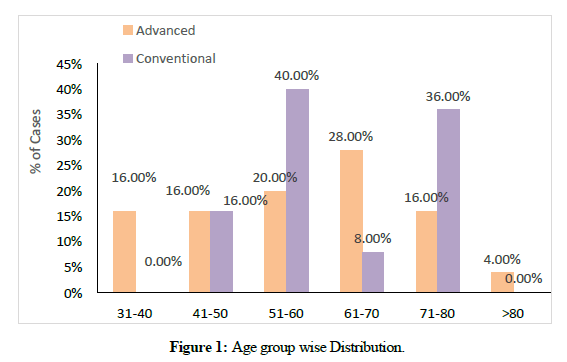
Figure 1: Age group wise Distribution.
Conventional Physiotherapy and standard medical treatment with Virtual therapy for upper and lower limb [bimeo, non-immersive VR] A.I assisted robotics therapy for upper and lower limb [lokomat, armeo,] music therapy [classical music, nature s’ sound, calming music, music with lyrics] and yoga [asana, downward facing dog, tree pose, child pose, kneeling half kneeling]
Group 2: In this group subjects necessitating occupational therapy, have received one of the following treatments:
conventional Occupational therapy which includes learning skills like dressing, bathing ,toileting ,eating ,drinking, training to improve balance and coordination, and return to work ,training to cope with challenges , adopting their living spaces developing equipment's for their home like chair ,grabbers and raised toilet seat , and standard medical treatment [Figure-2].
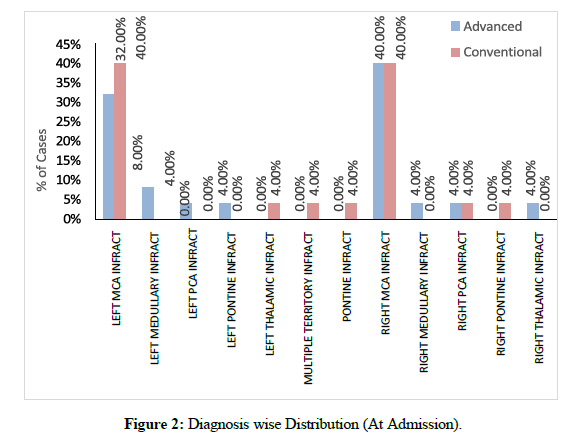
Figure 2: Diagnosis wise Distribution (At Admission).
Conventional occupational therapy and standard medical treatment with Virtual reality therapy for upper and lower limb [bimeo, non-immersive VR] A.I assisted robotics therapy for upper and lower limb [lokomat, armeo] music therapy [classical music, nature s’ sound ,calming music, and music with lyrics] and yoga [asana, downward facing dog, tree pose, child pose, kneeling half kneeling]
Group 3: In this group subjects necessitating speech therapy, have received one of the following treatments:
Conventional Speech therapy which includes oromotor exercise, swallowing therapy, MIT therapy pragmatic therapy behavioral modification therapy, output focused therapy, AAC therapy, postural therapy, and standard medical treatment [Figure-3].
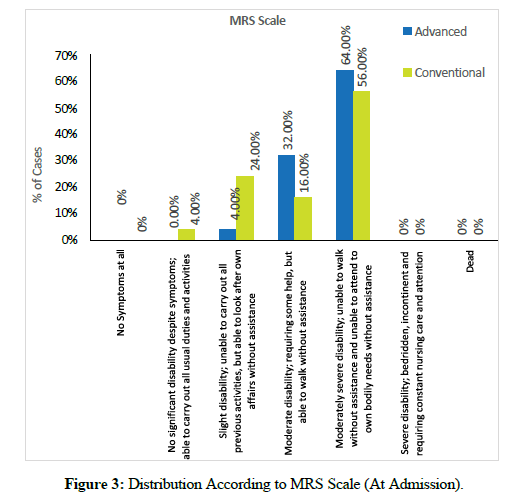
Figure 3: Distribution According to MRS Scale (At Admission).
Conventional speech therapy and standard medical treatment with Virtual reality therapy for upper and lower limb [bimeo, non-immersive VR], A.I assisted robotics therapy for upper and lower limb [lokomat, armeo] music therapy [classical music, nature s’ sound, calming music, and music with lyrics] and yoga [asana, downward facing dog, tree pose, child pose, kneeling half kneeling]
Group 4: In this group subjects necessitating cognitive therapy, have received one of the following
treatments:
Conventional Cognitive therapy which includes behavioral therapy, counseling, biofeedback, relaxation therapy and standard medical treatment
Conventional Cognitive therapy and standard medical treatment with Virtual reality therapy for upper and lower limb [bimeo, non-immersive VR], A.I assisted robotics therapy for upper and lower limb [lokomat, armeo] music therapy [classical music, nature s’ sound, calming music, and music with lyrics] and yoga [asana, downward facing dog, tree pose, child pose, kneeling half kneeling] [Figure-4].
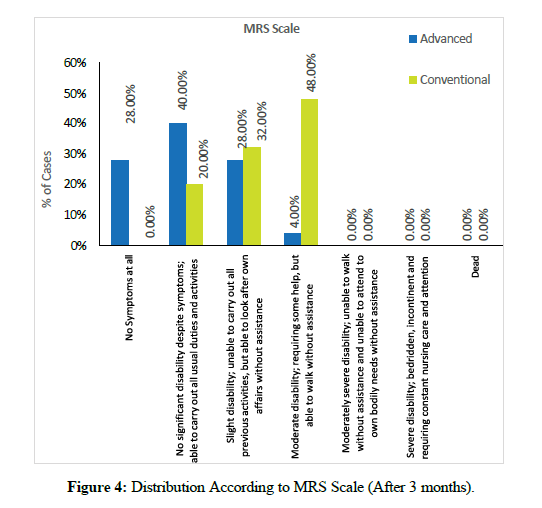
Figure 4: Distribution According to MRS Scale (After 3 months).
After 3 months of rehabilitation we have taken the data of the same patients through the same scales and calculated the data .after that we again continued the rehabilitation according to the group [Figure-5].
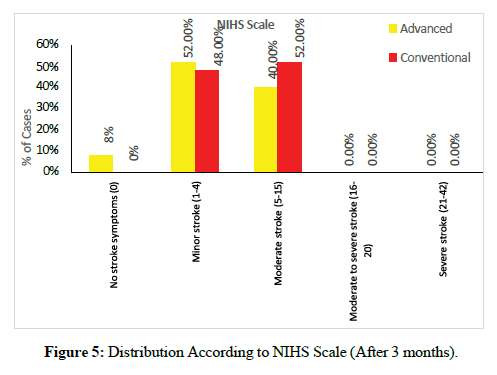
Figure 5: Distribution According to NIHS Scale (After 3 months).
RESULT
Conventional and newer technology tools were compared using the chi square test for quantitative variables according to the NIHS, MRS scales. There was a significant difference found in both the groups..p value was obtained by comparing both the groups [conventional rehabilitation and conventional plus advanced rehabilitation] after 3 months according to the NIHS scale the p value was 0.297 which is non-significant we have not observed considerable difference between advanced rehabilitation and conventional rehabilitation however we have perceived that cognition was improved greater at NIHS scale in advanced rehabilitation compared to the conventional rehabilitation ,according to the MRS there was highly significant value which was 0.0004 .we have observed that the advanced rehabilitation has given the finest result compared to the conventional rehabilitation [Figure-6].
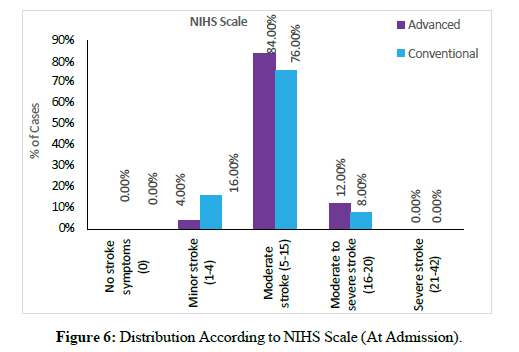
Figure 6: Distribution According to NIHS Scale (At Admission).
CONCLUSION
In this study both treatment groups obtained successful outcomes as measured by NIHS, MRS, There was significantly difference found between the two groups at these scales .the result of this study showed that the newer technology tools can decrease the cognitive impairment after stroke according to the nihs scale , there was also observed that newer technology tools give faster recovery as compared to the conventional rehabilitation alone .it was observed that newer technology tools not only improves mood and cognition function but also motivate patients to participate in rehabilitation making their recovery better.. It has been noticed through mmt scale that with advanced rehabilitation along with music and yoga and standard medical treatment patients were willingly participate in rehabilitation therefore the motor power of UL, LL both were improved in comparison to conventional rehabilitation. Neuronal plasticity helps rewiring lost neuron with healthy neuron over a period of time mostly in initially 8 weeks. Through enhancement of neuronal plasticity, newer neurotechnology added immensely in post stroke cognitive and motor improvement and more so in early months of stroke. So a early intense, combination of early and newer neurotechnology tools will be better. The process of spontaneous recovery after stroke is maximally expressed in the first 4 weeks post-stroke and then tapers off over 3 to 6 months. Several mechanisms are likely for this spontaneous recovery, including restitution of the ischemic penumbra, brain reorganization etc.. Conventional tools like Manual Stretching (AROM, PROM), aerobics, wheel chair exercise, walking, cycling, task specific exercises, cryotherapy, PNF works on same mechanism. Disuse atrophy is a common secondary complication of stroke and can result in muscle fiber changes. Electrical stimulation may also be able to reverse this by bringing about muscle fiber changes over the off course of treatment with type II glycolytic fibers reverting to type I oxidative skeletal muscle fibers. Type II fibers generate greater forces but fatigue more quickly whereas type I fiber produce lesser force but are more fatigue and resistance.
REFERENCES
- Sorbiun M, Shayegan E, Ramazani A, Mashhadi A. Biosynthesis of metallic nanoparticles using plant extracts and evaluation of their antibacterial properties. Nanochemistry Research.2018; 3(1): 1-16.
- Singh J, Dutta T, Kim K H, Rawat M, Samddar P, Kumar P. Green synthesis of metals and their oxide nanoparticles: applications for environmental remediation. Journal of nanobiotechnology.2018; 16(1): 1-24.
- Nalbandian L, Patrikiadou E, Zaspalis V, Patrikidou A, Hatzidaki E. Magnetic Nanoparticles in Medical Diagnostic Applications: Synthesis, Characterization and Proteins Conjugation. Current Nanoscience.2015; 12: 1-1.
- Venkateswarlu S, RaoY S, Balaji T, Prathima B, Jyothi N. Biogenic synthesis of Fe3O4 magnetic nanoparticles using plantain peel extract. Materials Letters.2013; 100: 241-244.
- Kusigerski V, Illes E, Blanusa J, Gyergyek S, Boskovic M, Perovic M et al. Magnetic properties and heating efficacy of magnesium doped magnetite nanoparticles obtained by co-precipitation method. Journal of Magnetism and Magnetic Materials. 2019; 475: 470-478.
- Zhou Y, Yan D, Yuan S, Chen Y, Fletcher E, Shi H et al. Selective binding, magnetic separation and purification of histidine-tagged protein using biopolymer magnetic core-shell nanoparticles. Protein Expression and Purification.2018; 144: 5-11.
- Zulfiqar N, Shariatipour M, Inam F. Sequestration of chromium(vi) and nickel(ii) heavy metals from unhygienic water via sustainable and innovative magnetic nanotechnology. In Nanoscale advances. 2023; 287-301.
- Zulfiqar N, Shariatipour M, Inam F. Sequestration of chromium (vi) and nickel (ii) heavy metals from unhygienic water via sustainable and innovative magnetic nanotechnology. Nanoscale Advances.2024; 6(1): 287-301.
- Cho J S, Hong Y J, Kang Y C. Design and Synthesis of Bubble-Nanorod-Structured Fe2O3–Carbon Nanofibers as Advanced Anode Material for Li-Ion Batteries. ACS Nano.2015; 9: 4026.
- Asoufi H M, Al-Antary T M, Awwad A M. Magnetite (Fe3O4) Nanoparticles Synthesis and Anti Green Peach Aphid Activity (Myzuspersicae Sulzer). Journal of Computational Biology. 2018; 6.
Indexed at, Google Scholar, Crossref
Indexed at, Google Scholar, Crossref
Indexed at, Google Scholar, Crossref
Indexed at, Google Scholar, Crossref
Indexed at, Google Scholar, Crossref
Indexed at, Google Scholar, Crossref
Indexed at, Google Scholar, Crossref
Citation: Nahid K (2024) Assessment and management of Cognition and motor impairment after stroke through exploratory data analysis and formulation of a model incorporating conventional existing and newer neuro-technology tools. J Nanomed Nanotech. 15: 737.
Copyright: ©2024 Nahid K. This is an open-access article distributed under the terms of the Creative Commons Attribution License, which permits unrestricted use, distribution, and reproduction in any medium, provided the original author and source are credited.


